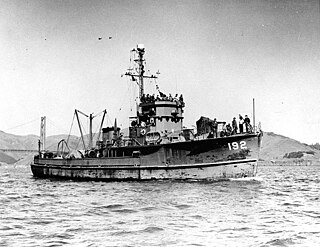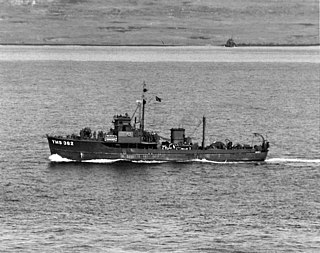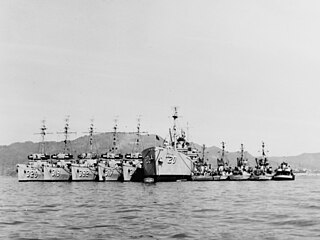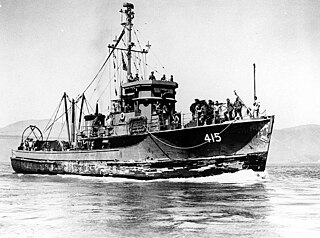
USS Hornbill was a YMS-1-class minesweeper of the YMS-135 subclass built for the United States Navy during World War II. After World War II, she continued to be in use until the mid-1950s.

USS Lapwing was a YMS-1-class minesweeper of the YMS-135 subclass built for the United States Navy during World War II. She was named after the lapwing.

USS Heron was a YMS-1-class minesweeper of the YMS-135 subclass built for the United States Navy during World War II.

USS Turkey (AMS-56/YMS-444) was a YMS-135 subclass of YMS-1-class minesweepers built for the United States Navy during World War II.

USS Lark was a YMS-1-class minesweeper of the YMS-135 subclass built for the United States Navy during World War II.

USS Pelican was a YMS-1-class minesweeper of the YMS-135 subclass acquired by the U.S. Navy for the task of removing mines that had been placed in the water to prevent ships from passing.
USS Flamingo was a YMS-1-class minesweeper of the YMS-135 subclass built for the United States Navy during World War II. She was the third U.S. Navy ship to be named for the flamingo.

USS Plover was a YMS-1-class minesweeper of the YMS-135 subclass built for the U.S. Navy during World War II.

USS Crossbill was a YMS-1-class minesweeper built for the United States Navy during World War II. She was the second U.S. Navy ship to be named for the crossbill.

USS Grouse (AMS-15/YMS-321) was a YMS-1-class minesweeper of the YMS-135 subclass built for the United States Navy during World War II.

USS Condor was a YMS-1-class minesweeper of the YMS-135 subclass built for the United States Navy during World War II. She was the second U.S. Navy ship named for the condor.

USS Hawk was a YMS-1-class minesweeper of the YMS-135 subclass built for the United States Navy during World War II.
USS Linnet (AMS-24/YMS-395) was a YMS-1-class minesweeper of the YMS-135 subclass built for the United States Navy during World War II.

USS Courser was a YMS-1-class minesweeper of the YMS-135 subclass built for the United States Navy during World War II. She was the second ship of the U.S. Navy to be named Courser.

USS Curlew was a YMS-1-class minesweeper of the YMS-135 subclass built for the United States Navy during World War II. She was the fourth U.S. Navy ship to be named for the curlew.

USS Chatterer (AMS-40/YMS-415) was a YMS-1-class minesweeper of the YMS-135 subclass acquired by the U.S. Navy for the task of removing mines that had been placed in the water to prevent ships from passing.

USS Fulmar (AMS-47/YMS-193) was a YMS-1-class minesweeper of the YMS-135 subclass acquired by the U.S. Navy for use in World War II. Her task was to clear minefields in coastal waterways.

USS Flicker (AMS-9/YMS-219) was a YMS-1-class minesweeper of the YMS-135 subclass acquired by the U.S. Navy for clearing coastal minefields during World War II.

USS Nightingale was a YMS-1-class minesweeper of the YMS-135 subclass acquired by the U.S. Navy for the dangerous task of removing mines from minefields laid in the water to prevent ships from passing.

USS Lorikeet (AMS-49/YMS-271) was a YMS-1-class minesweeper of the YMS-135 subclass acquired by the U.S. Navy for the task of removing mines from water that had been placed there to prevent ships from passing.











